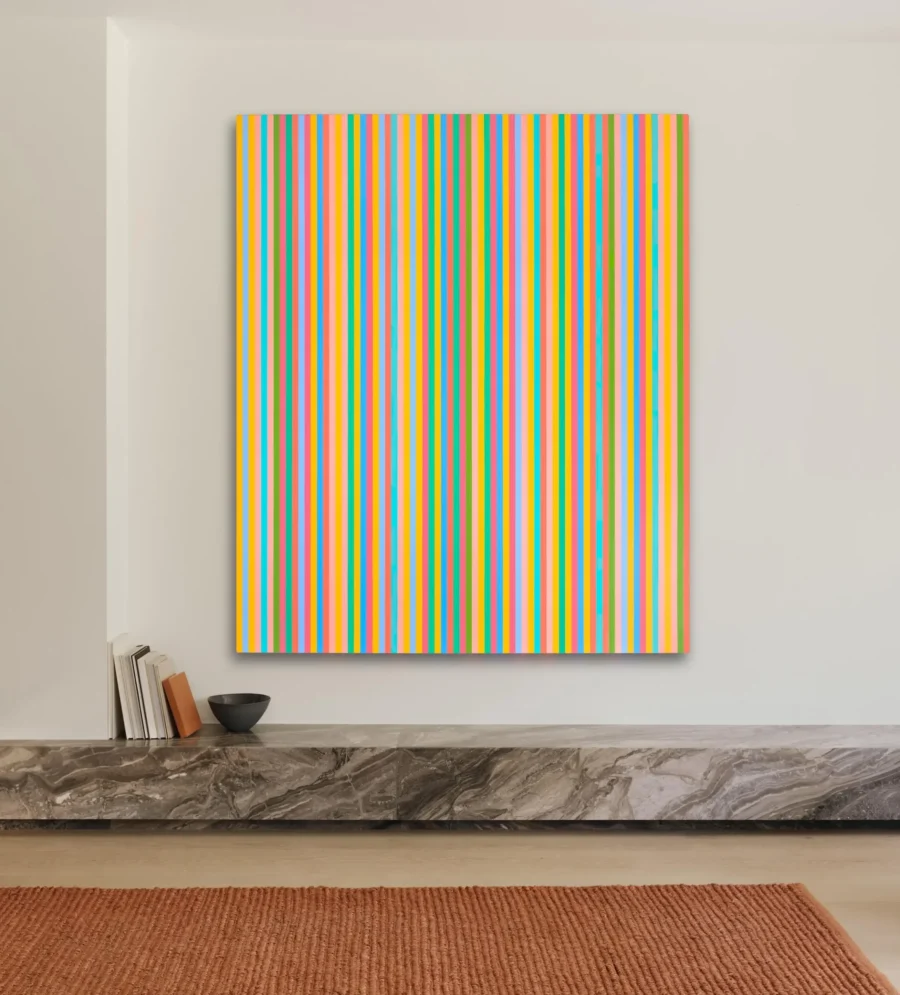Bridget Riley, one of the most celebrated pioneers of Op Art, has once again captured the attention of the global art market. In a dramatic and much-publicized auction at Bonhams in late March 2025, her seminal 1980s painting Myrrh fetched an astonishing $2.36 million. This result not only marks one of the highest prices ever paid for a Riley work but also signals a powerful resurgence of interest in Op Art and its enduring legacy in contemporary collecting.
A Record-Breaking Moment
The Bonhams auction, held in London, featured several high-profile lots, but none drew more excitement than Myrrh. Executed in 1984, the painting showcases Riley’s signature precision and optical intensity. The final hammer price far exceeded its presale estimate of $1.5 to $2 million, sparking spirited bidding among collectors from Europe, the U.S., and Asia. When the gavel fell at $2.36 million, the room erupted in applause, a rare but telling gesture of the painting’s impact.
This sale not only represents a personal milestone for Riley, now in her 90s, but also positions her among the most valuable living British artists. Her market trajectory reflects a growing recognition of the intellectual and aesthetic significance of her work, which has long been celebrated in institutional contexts.
The Power of Myrrh
Myrrh is a masterclass in Riley’s command of line, color, and movement. Composed of a rhythmic sequence of curved vertical stripes in warm and cool hues, the painting appears to shimmer and pulse before the viewer’s eyes. Its ability to challenge visual perception and evoke a sense of motion without literal representation exemplifies Riley’s unique contribution to 20th-century abstraction.
What sets Myrrh apart is its subtle yet profound shift from the stark black-and-white compositions of Riley’s early career to her later, more color-infused works. This transition not only broadened her aesthetic vocabulary but also cemented her place as a dynamic force in modern and contemporary art.
Op Art: From Controversy to Coveted
Op Art emerged in the 1960s as a bold and, at times, controversial movement. Critics initially dismissed it as decorative or gimmicky, yet artists like Riley and Victor Vasarely pushed the boundaries of visual perception, introducing a new dialogue between science and aesthetics. Over time, this once-marginalized genre gained critical acceptance and institutional support, culminating in major retrospectives and scholarly reassessments.
The resurgence of interest in Riley’s work, as demonstrated by the Bonhams sale, is part of a broader reevaluation of Op Art’s cultural and historical significance. As collectors seek works that are both visually engaging and intellectually rigorous, Op Art is enjoying a renewed moment in the spotlight.

Riley’s Timeless Appeal
Bridget Riley’s career spans more than six decades, yet her work remains as vital and relevant as ever. She continues to create new pieces, and her influence can be seen in the practices of younger artists exploring perception, pattern, and color. Museums worldwide continue to celebrate her contributions, with major institutions like the Tate and The Museum of Modern Art regularly featuring her in permanent collections and exhibitions.
The success of Myrrh reaffirms Riley’s status not just as a pioneer of a niche movement but as a central figure in the canon of modern art. Her art transcends trends, appealing to seasoned collectors and new audiences alike.
Market Momentum and Future Prospects
The art market in 2025 is marked by both uncertainty and opportunity. While some sectors struggle with fluctuating interest, the demand for iconic, museum-quality works remains strong. The Bonhams auction is a prime example of how provenance, rarity, and artistic merit converge to produce exceptional outcomes.
Riley’s Myrrh was particularly well-positioned, given its strong exhibition history and its embodiment of the artist’s mature style. Analysts believe this sale will encourage further interest in similar works from the Op Art movement, especially those by female artists whose contributions have historically been undervalued.
The Role of Auction Houses
Auction houses like Bonhams are increasingly vital players in shaping artistic reputations and market narratives. By spotlighting works like Myrrh, they help recalibrate public and collector perceptions. The dramatic sale result suggests that the right context and curation can significantly enhance an artwork’s market appeal.
Bonhams’ strategic placement of Myrrh as a centerpiece of its contemporary art sale was instrumental in generating buzz and attracting top-tier bidders. This reflects a broader trend among auction houses to reframe mid-to-late 20th-century art within contemporary contexts.
Gender and Recognition in the Art World
Riley’s success is also significant within the broader discourse on gender in the arts. Despite the progress of recent years, female artists still face disparities in representation and valuation. Riley’s record-breaking sale serves as a powerful counter-narrative, highlighting the excellence and market potential of women artists.
Collectors and institutions alike are increasingly aware of these disparities and are actively working to diversify their acquisitions. The prominence of Myrrh in such a high-profile setting may inspire further efforts to elevate other overlooked or underappreciated talents.
Public and Institutional Reactions
The art world responded swiftly to the Bonhams result. Curators, critics, and fellow artists lauded the sale as a milestone for Riley and a barometer of shifting tastes. Several institutions reportedly expressed interest in acquiring similar works, suggesting a ripple effect in both public and private collections.
Social media buzzed with commentary, as art influencers and galleries shared images and reflections on the painting. The convergence of academic esteem and market enthusiasm is rare, but Myrrh has managed to bridge that divide with elegance and force.
Looking Ahead
The sale of Myrrh is more than a financial transaction. It is a cultural moment that underscores the lasting impact of Bridget Riley’s vision. As her market ascends, so too does the appreciation for the complexity and beauty of Op Art.
Collectors are advised to watch this space closely. With rising demand, limited supply, and growing critical support, works by Riley and her contemporaries are poised for continued growth. For now, Myrrh stands as a beacon of this movement’s potential and a testament to the enduring power of perceptual painting.
Bridget Riley’s Myrrh setting a record at Bonhams is a historic milestone that reverberates across the art world. It signals not just the financial strength of her market but the profound and lasting resonance of her artistic vision. As the dust settles from this landmark sale, one thing is clear: Op Art, led by Riley’s unwavering brilliance, is not just back. It never left.
#BridgetRiley #OpArt #BonhamsAuction #ContemporaryArt #WomenInArt #ArtMarket2025 #MyrrhPainting #VisualPerception #ArtCollectors #ModernArt









